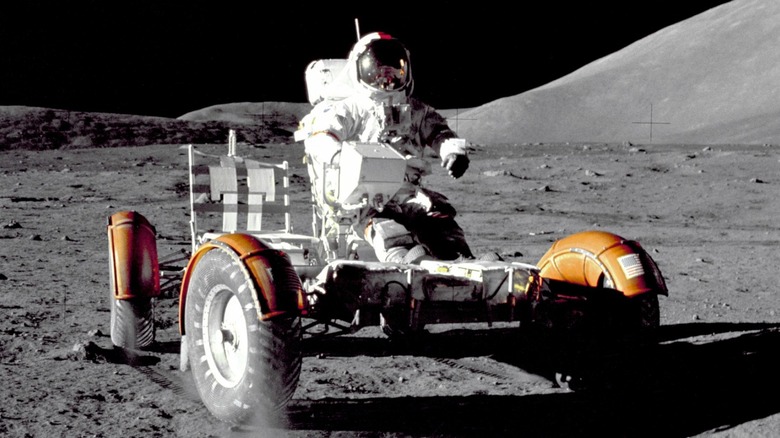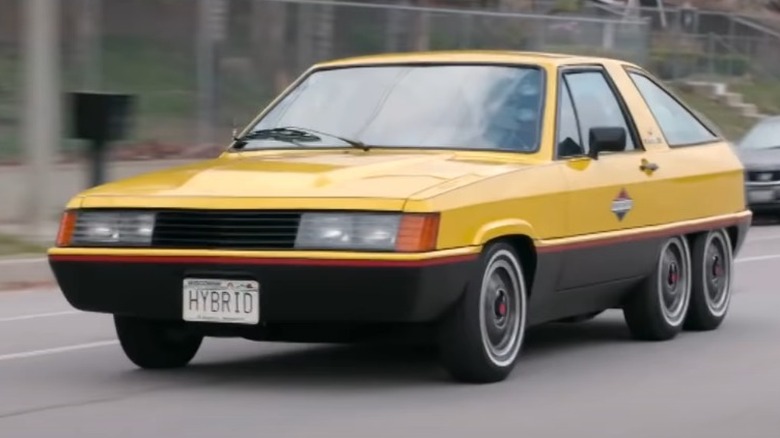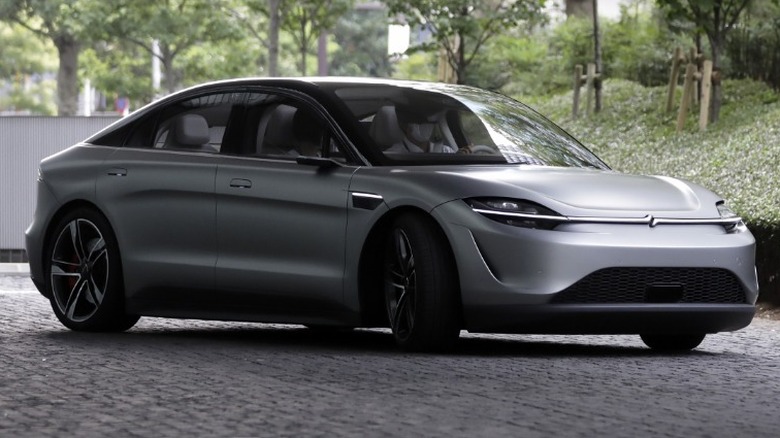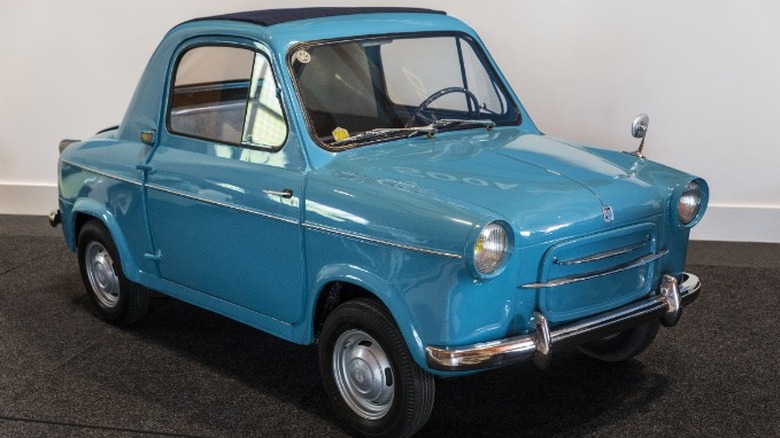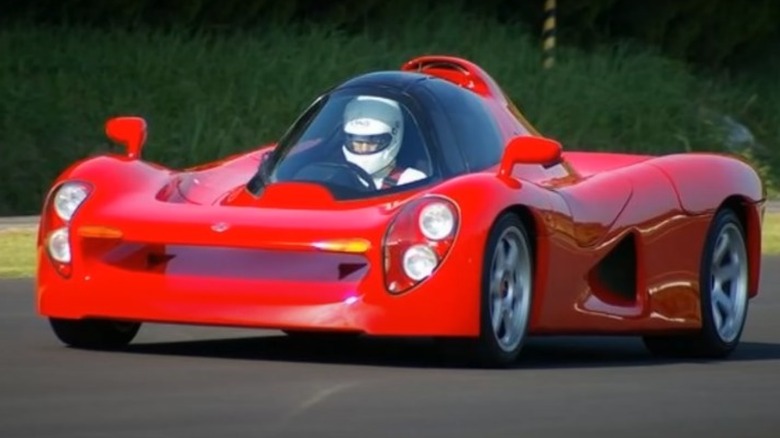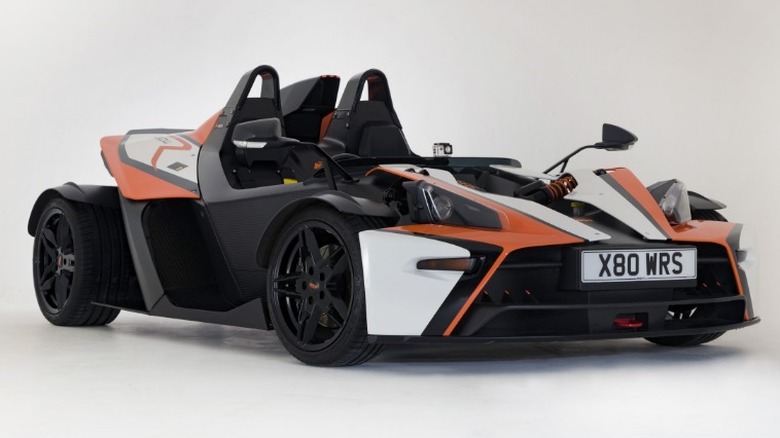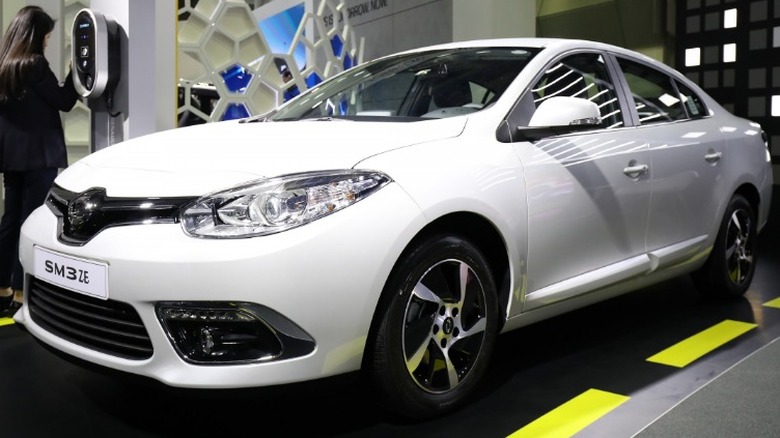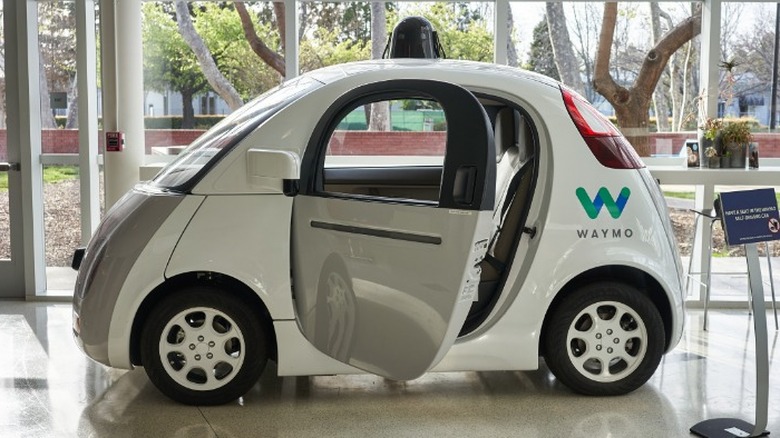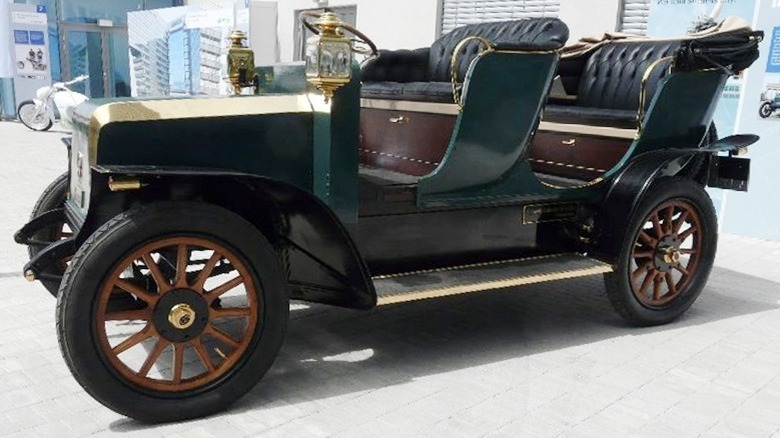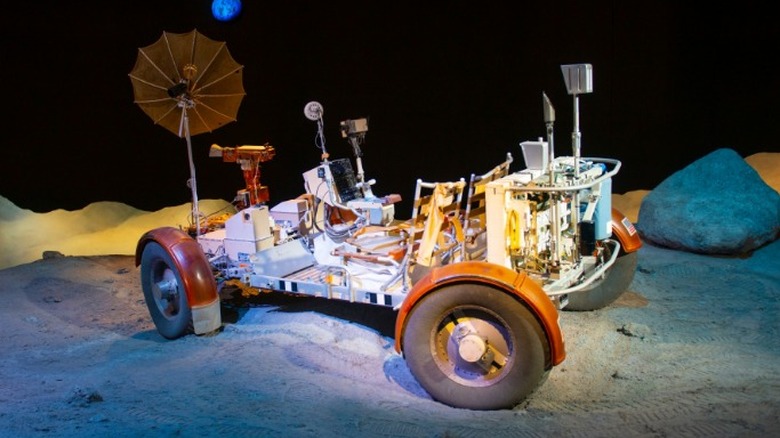Fascinating Cars That Were Made By Non-Car Companies
Since the first car set to the streets, countless manufacturers from all over the globe have attempted with varying results to create cars that will sell. But occasionally, companies that make other products have attempted to enter the automobile market, also with varying success, leaving behind some rather interesting concepts and production vehicles.
The reasons a company would want to build a car despite lacking expertise in automaking runs on a spectrum. Some modern technology companies work in a space with adjacent technologies that are already found in electric cars, while manufacturers from earlier days produced mechanical components with similar properties to the automobile. Other companies have large research and development departments that offer novel ideas to create a better car. Many of our most recognizable brands did not get their start making cars, such as Studebaker and Mazda, and entering the automobile business was probably a good way to make profits from changes happening in the marketplace.
Regardless of the reasoning, many companies have tried their hand at automaking. Most of them have not continued, leaving us stories of some interesting ideas that could have been. So, here are 10 fascinating cars made by non-car companies.
Briggs & Stratton Hybrid
The company most well-known for making the engines that cut our grass each year is the corporate giant Briggs & Stratton. According to the manufacturer, the company was founded in 1908 to build and supply gasoline engines largely for agricultural and military applications. Briggs & Stratton once made the four-wheel Flyer, but that was more of an early go-kart than car. However, it is the 1980 prototype car that is much more interesting.
The idea of combining electric power with internal combustion is nothing new, but the 1980 Briggs & Stratton Hybrid is the most peculiar example. Its styling is much like contemporary imported Japanese cars, but its internals are wholly unique. According to Road and Track, the car used a gas engine up front with a dozen lead-acid batteries in the rear hatch. The most striking feature is its six wheels, included as a result of the extreme weight of the batteries. The rear tires are connected to an axle supporting the battery tray, relieving the car's suspension from the extra strain. The engine is the same 2-cylinder engine found in riding lawnmowers and produces 18 horsepower parallel to the electric motor, meaning the car can run on gas or electricity, or both.
As cool and unique as this prototype is, it was always just an engineering exercise with no production intent. Fortunately, it was kept by the company and today it serves a promotional role as a sort of trophy to the ingenuity of Briggs & Stratton as a manufacturer.
Sony Vision-S
With the explosion of electric cars as of late, more companies are getting into automaking than ever. The lack of testing and certification from the EPA eliminates a large expense from development. Furthermore, companies already involved in high-tech electronics are well-positioned to create their own vehicle. Sony is a perfect example of such a company, and it has recently been testing an EV for possible mass production.
Car and Driver posits that the Sony Vision-S could be a competitor to the Tesla Model Y due to its similar size and complement of impressive electronics. The specs are impressive, with a dual-motor arrangement pushing 536 horsepower through all four wheels. The prototype model displays a long line of screens across the dashboard with smaller complementary screens for use by the rear passengers on the back of the headrests. Its styling will ruffle no feathers, as Sony appears to be taking a conservative approach to design — which is consistent with Sony's history of making rock-solid products with minimal flair.
Grumman LLV
Before its merger with Northrop, the Grumman Corporation was responsible for some of the fiercest aircraft at the disposal of the American military. Some of Grumman's most successful products include the Navy F-14 Tomcat, Gulfstream II business jet, and Apollo Lunar Module. Before its eventual merger with Northrop, Grumman received the contract to build a new vehicle to replace the U.S. Post Office Jeep.
The current postal vehicle, called Long Life Vehicle (or LLV), is at the end of its life and in the process of being replaced, with Oshkosh chosen in 2021 to build the first new postal carrier vehicle in 30 years. Grumman's design was obviously durable, as it has outlasted its planned 20-year lifespan by a decade. Grumman's LLV design won because it held up to the standards required by the contract. The Smithsonian states the requirements included driving 11,520 miles on a gravel road over 960 potholes at 10-14 mph, and 5,760 miles at 50-55 mph on a closed loop. The total order was valued at more than a billion dollars, with each LLV costing $11,651.
Amazingly, all of the tens of thousands of these vehicles still being used today were built before 1994 and are used six or seven days a week all year long.
Vespa 400
After World War II, the countries of Europe had an enormous need for affordable transportation, yet had a decimated industrial base. Many companies dedicated to building armaments and equipment for the military were also left with idle factories and nothing to sell. One of these companies began using leftover aircraft parts to build small, efficient, and affordable motor scooters that would buzz through the streets of Italy. Because of this buzzing sound, they would be called a wasp, or Vespa in Italian. Inspiration for the scooter came from scooters dropped with paratroopers during the war but crafted with Italian style (via Italy Magazine).
In the late '50s, Vespa put its efforts into a microcar sharing many mechanical attributes of its scooters. Using a 400cc air-cooled engine mounted in the rear, the Vespa 400 was not fast, but it was stylish. Hemmings says the car was only built from 1958-1961 and the 2-cylinder engine only produced 14 horsepower. Everything about it was basic, with the only gauge being a speedometer that included a light to indicate low fuel level. While the Vespa 400 was a practical and usable car, vehicles such as the Austin Mini and VW Beetle kept it from succeeding. Production peaked at 28,000, with only 1,700 ever arriving in the States.
Yamaha OX99-11
For decades, the Yamaha corporation has been the manufacturer of finely crafted musical instruments as well as finely crafted motorcycles. With its experience and expertise in engineering, it has often been asked to lend a hand in the creation of specialty automobiles, such as the Toyota 2000GT and the Ford Taurus SHO. But it was in the '90s that Yamaha created its own complete car model, called OX99-11.
This was an F1-inspired car featuring a 10,000 revolution-per-minute-capable V12 engine derived from F1 technology, according to MotorTrend. The car sits low and has only a single occupant positioned in the center, and looks like it belongs on a track more than the street. However, it was designed and built as a passenger vehicle for the road. Yamaha completed three of its concept cars, which rode on a carbon fiber chassis with up to 400 horsepower and looked cooler than anything on the road then, and possibly today. Unfortunately, the program was canceled six months after the cars were built due to budget concerns. Fortunately, Yamaha has kept these cars around and uses them on test tracks regularly rather than keeping them mothballed in the back of a storage facility out of view.
KTM X-Bow
The Austrian company KTM is known worldwide for its range of capable motorcycles, with particular expertise in creating formidable off-road machines. The company branched out into making road-going bikes in the '90s and has been expanding its lineup ever since. Further expanding its scope and entering into new markets brought the company's more recent road-going endeavor, the X-Bow. This sets a new course for the company as it uses four wheels and carries passengers in bucket seats rather than a saddle.
The X-Bow debuted in 2011 as an open-top, mid-engine track car that is certified to be road legal only in some jurisdictions. Car and Driver reported that the car would begin sales in the U.S. in 2017, but only as a track car as its lack of ABS and airbags meant it could not pass legal DOT requirements. Still, it is a cool toy, getting its power from a 2.0-liter Audi 4-cylinder engine with turbocharger, per Car Magazine. It is good for 296 horsepower, which gives the 1,741-pound car an impressive power-to-weight ratio. Otherwise, it is an austere experience with nothing to distract the driver from the pavement ahead.
Despite the advantages on a race track presented by the car, Jeremy Clarkson demonstrated in an episode of "Top Gear" just how ridiculous this car is to live with anywhere else, as it is wholly impractical. That said, an upcoming version by KTM will have a roof and double the power, and should be rather impressive and road-legal.
Samsung SM3 Z.E
As an American or even a European, it is probably hard to grasp how all-encompassing the Samsung corporation is in Korea, as the company makes dozens of products used every day and also has many financial operations. People all over the globe are familiar with Samsung telephones and many still have its electronics and appliances, but, in some markets, people could drive Samsung cars.
Samsung's foray into automaking began in the '90s with cooperation from Renault (per CarBuzz). In this joint manufacturing agreement, many of the models manufactured by Samsung are mostly rebadged Renault models, however, some models have been jointly developed in Korea and exported around the world, such as the QM6, as reported by The Korea Herald. SlashGear also reported in the spring of 2022 that Samsung has released a full-electric car, the SM3 Z.E, a genuinely affordable electric car with a list price of about $29,100 — although it will not be making it stateside.
These cars themselves are not essentially anything outlandish. They are, in fact, more mundane than anything. However, the novelty to many Western sensibilities is the fact that Samsung also makes cars, along with ocean liners, mobile phones, insurance policies, dishwashers, televisions, skyscrapers, and much more. No conglomerate in the U.S., no matter how big, has that kind of integration into society.
Waymo Firefly
Waymo is a Google subsidiary dedicated to developing fully autonomous driving capability. Many of its developments have been used to retrofit existing production cars with its technology, but the Firefly is an all-new design that could be the first autonomous car.
Waymo began, according to Forbes, as a project by one of Street View's inventors as a project of Google. It has been working toward creating self-driving cars, initially retrofitting Toyota Prius vehicles with Chrysler Pacifica vans following. Development has continued over the years, with fully autonomous vehicles being used in a test program on the streets of Phoenix, and plans to expand to other cities.
Waymo expanded the project by creating a car from the ground up called the Firefly in 2015, which was tested on the streets of Austin, TX. While many autonomous pilot programs require humans at the wheel to monitor the car, mostly for safety reasons, SlashGear recently reported that the newest Waymo car – an autonomous taxi – has no steering wheel. Each passenger will have a screen to interact with the taxi and it can be summoned through an app on a mobile phone. While the Waymo Firefly has some time to go before it sees widespread adoption, it has laid significant groundwork for a possible future with no drivers.
Electric Viktoria by Siemens
Siemens is a well-known German conglomerate heavily involved in electronics and communications. The history of the company dates back to 1847 when Werner Siemens started building telegraphs and later developing many pioneering devices used in the production of electricity, founding what would become one of the largest companies in Germany (via National Magnet Lab). This company would branch out into many areas, including transportation, which it is still involved in today with its high-speed trains.
Being a pioneering company always working on upcoming technologies, Siemens came up with many ideas in communications, mobility, and electricity. One of them was a car in 1905. It was, according to the manufacturer, one of the first cars to drive through Berlin on battery power alone. The car was called Electric Viktoria, and it served as a hotel taxi for an upscale establishment. Its top speed was about 19 mph with a range of about 50 miles. The battery weighed in at about 1,000 pounds, and could be replaced with the help of a pulley or simply recharged, although charge time was likely very lengthy in its day.
[Featured image by Heron.Alexandria via Wikimedia Commons | Cropped and scaled | CC BY-SA 3.0]
NASA Lunar Roving Vehicle
A vehicle only meant for driving on the moon is no less a car. It has a motor and four wheels, but it requires no turn signals or a horn. Developed by NASA with assistance from Boeing, the Lunar Roving Vehicle transported astronauts across the surface of the moon, although it has yet to be tested in heavy traffic.
The Lunar Roving Vehicle is a battery-powered open-air car made from lightweight aluminum and fiberglass that rides on airless mesh tires designed specifically for this project. The total weight is just 537 pounds (via Smithsonian). Through all the Apollo missions, three vehicles rode on the surface of the moon for distances up to 12.5 kilometers, the longest voyage. The chassis is hinged to be folded up in the capsule, each wheel had an independent motor, and the battery was not rechargeable, according to NASA.
The Apollo missions were a rousing success, with the Lunar Rovers being integral to the missions and partly responsible for the vast amount of data collected. They also serve as a testament to the ingenuity of the NASA program and how it managed to send astronauts to space with a car that performed admirably. The tires are ingenious, made from thin strands of woven steel and covered by titanium chevrons to create traction. The legacy of the Lunar Roving Vehicle looms large on future space programs as we continue to explore beyond our planet, and these contributions of past space explorers continue to guide our efforts today.
